My dear friend Amanda teaches composting, canning, gardening, and food preservation courses. During the pandemic, I took every one of them, and during a “How To Compost” course, she recommended freezing certain vegetable scraps instead of composting them to make stock. This method of making vegetable stock is just genius. I don’t know why I hadn’t thought of it sooner! So, I’m paying it forward in case you were unaware.
If you haven’t heard of freezing the stems of herbs, skins, and ends of onions and garlic, peels from carrots, scraps from celery, etc., do it. You’ll save yourself so much money, and your homemade stock will be better than what you can buy at the store. Keep a gallon-sized bag in your freezer, and whenever you have any vegetable scraps that you’d like to make stock with, put them in that bag. When you fill the bag at least halfway, you can make stock.
I love having stock already made in my freezer, ready for when someone gets sick and I need to make chicken noodle soup. I also use my ready-made stock in yellow rice, stews, and butternut squash soup. It’s a time saver and a way to fortify my food for my picky eater.
If you don’t have scraps on hand but need stock, you can purchase vegetables and use this same cooking method. The result will be a delicious homemade vegetable stock. Just make sure you have 8 cups of vegetables.
iBuen provecho!
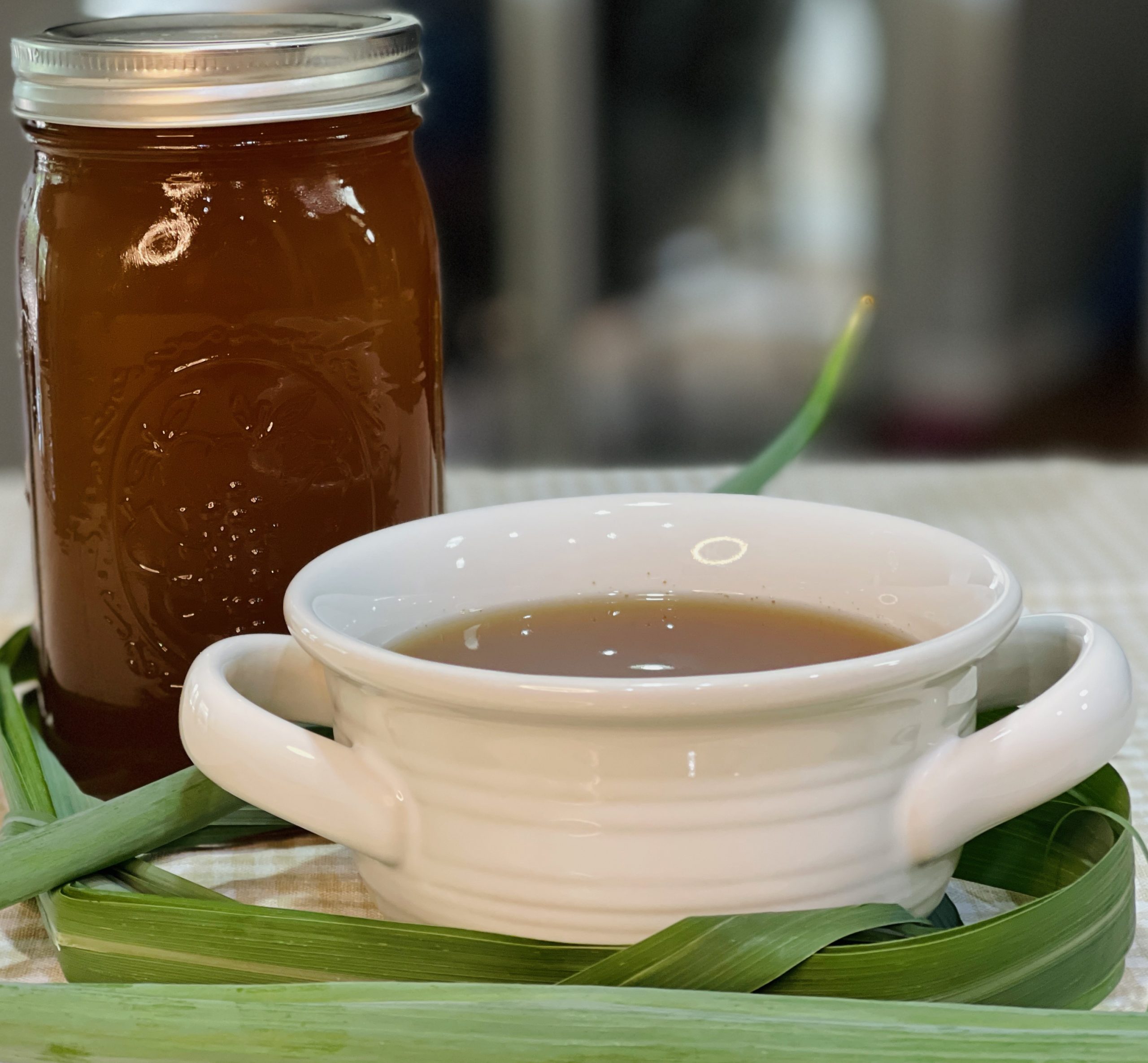
A Rich No-Waste Vegetable Stock Made With Vegetable Scraps
Equipment
- 8 qt Stockpot (or Pressure Cooker)
- Large Fine-Mesh Strainer ( or Colander)
Ingredients
What to freeze:
- tomato skins and tops
- bulb onion skins and cut tips i.e. Spanish onions, yellow onions, sweet onions, red onions, shallots, etc.
- carrot peels and ends
- celery scraps, leaves, and ends
- garlic peels, cut tips, and scraps
- herb stems and leaves
- any green onion scraps i.e. scallions
- leeks trimmings rinsed very well
- lemongrass
- mushroom trimmings i.e. portobello stalks
- ginger peels
- cobs of corn
- bell pepper stems, seeds, leaves, and scraps
For the broth:
- 8 cups vegetable scraps or a half-full gallon-sized freezer bag
- 2 tsp whole black peppercorns you can substitute with 1 tsp ground pepper
- 8 cups water
- 1 tsp salt
Optional:
Instructions
How to freeze vegetable scraps:
- Place the vegetable scraps in the freezer bag, remove all excess air, seal completely, and store in the freezer for up to 10 months.
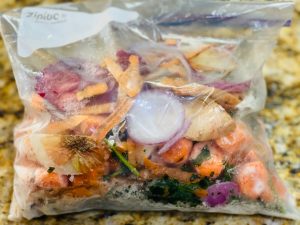
To make stock:
- In an 8 qt stockpot or pressure cooker, add the frozen vegetable scraps.
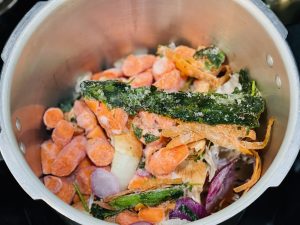
- Measure the depth of the vegetables and double the depth by adding water, approximately 8 cups of water. If you're using a pressure cooker, do not fill more than ⅔. Overfilling can cause liquid to spew from the pressure release valve.
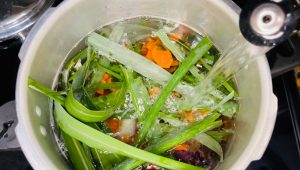
- Add in the salt, whole black peppercorns, and optional bay leaves.
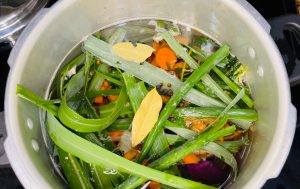
If using a stockpot:
- Over high heat, bring to a boil and then cover and lower to a simmer over medium-low to low heat.
- Let simmer for 4-12 hours; the longer, the better.
- After at least 4 hours, taste the vegetable stock. You're looking for a rich vegetable flavor; if it tastes like watered-down tea, you need to cook it longer.
- When your vegetable stock is ready, place a colander or a large fine-mesh strainer into another large pot or mixing bowl and pour out the contents from your stockpot into the strainer. Lift the strainer, containing all of the vegetable scraps, from the large pot or mixing bowl and hold it just above, filtering out the last drops of stock.
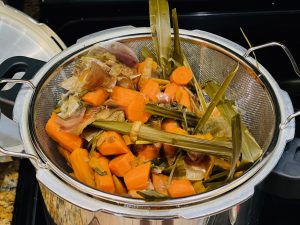
- You should only have vegetable stock left in the pot or bowl. Set aside to cool. Use immediately, refrigerate for up to 5 days, or store in the freezer for no longer than 3 months.
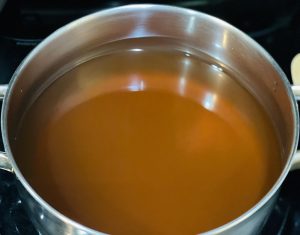
If using a pressure cooker:
- Secure pressure cooker lid and raise heat to high heat.
- Once you hear the pressure cooker hissing, lower heat to low and leave to cook for 2-4 hours; the longer, the better.
- After at least 2 hours, release all of the pressure from the pressure cooker until the float valve drops and you no longer hear steam escaping. Taste the vegetable stock. You're looking for a rich vegetable flavor; if it tastes like watered-down tea, you need to cook it longer.
- When your vegetable stock is ready, place a colander or a large fine-mesh strainer into another large pot or mixing bowl and pour out the contents from your pressure cooker into the strainer. Lift the strainer, containing all of the vegetable scraps, from the large pot or mixing bowl and hold it just above, filtering out the last drops of stock.

- You should only have vegetable stock left in the pot or bowl. Set aside to cool. Use immediately, refrigerate for up to 5 days, or store in the freezer for no longer than 3 months.

No-Waste:
- Freeze any vegetables you have on hand that may expire before you're able to use them.
Pro Tip:
- If using a stockpot, once you bring your stock to a boil, you can set your oven to 200 degrees, remove the lid and let it cook low and slow overnight. I do not recommend this method for households with small children or ovens without locking mechanisms.
- Leave 1" of space if using glass Ball jars to store your stock in the freezer.
Notes
Did you make this recipe?
Please let me know how it turned out for you! Leave a comment below, tag @domesticgourmet on Instagram, and hashtag #domesticgourmet.

I love this idea for making vegetable stock! Super easy and most important, no waste, 🙂 thank you for posting Cigi
This was my first go at making homemade stock and it turned out delicious. I am excited to turn it into soup. Not only did the stock turn out well, but my whole house smelled amazing all day. My next batch I will save more types of veggies and see how it impacts the flavor. I will definitely be repeating this recipe.
So…I don’t have to blanch anything?? Amazing. Also do you think it would be good or bad to just blend it all together for more of a stew broth at the end? I have a strong food processor. Thank you for posting!
Hi Moi! Great question! If you’re using scraps, I would recommend straining and not blending.